|
Rick Archer's Note: This page is
the original promotion page for our trip. It contains Information
about each stop on our trip at a glance.
|
The SSQQ 2009
Barcelona Cruise
Sunday,
September 27th -
Sunday, October 4th
A 7-day cruise through the Western Mediterranean Triangle aboard
Royal Caribbean's Voyager of the Seas
|
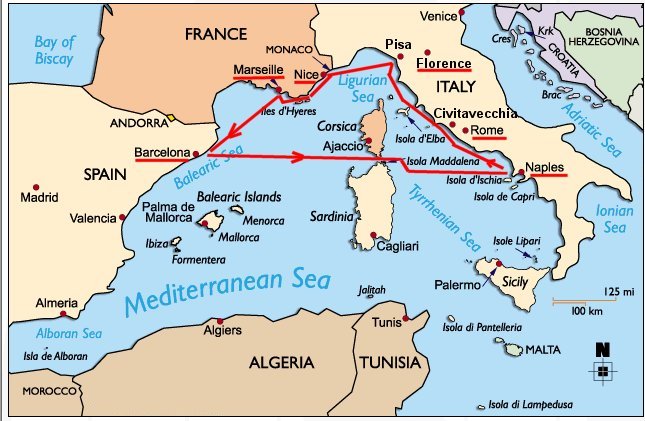 |
|
Your chance to see the Leaning Tower
of Pisa,
Mount Vesuvius and Pompeii, Michelangelo's David,
the Spanish Flamenco, the Roman Colosseum, the
Paintings and
Sculpture of the Renaissance,
the Swiss Alps, the Casinos of Monaco,
and the Beaches of Nice!
Day One:
Barcelona, Spain --
Departs 7:00 pm
Day Two:
Fun Day at Sea Cruising the Mediterranean
Day Three:
Naples/Capri, Italy -- 7 am - 7 pm
Day Four:
Rome, Italy -- 7
am - 7 pm
Day Five:
Florence/Pisa -- 7
am- 7 pm
Day Six:
Nice, France -- 7
am - 7 pm
Day Seven: Marseilles, France -- 7 am -
7 pm
Day Eight:
Barcelona, Spain -- Arrive
7:00 am
|
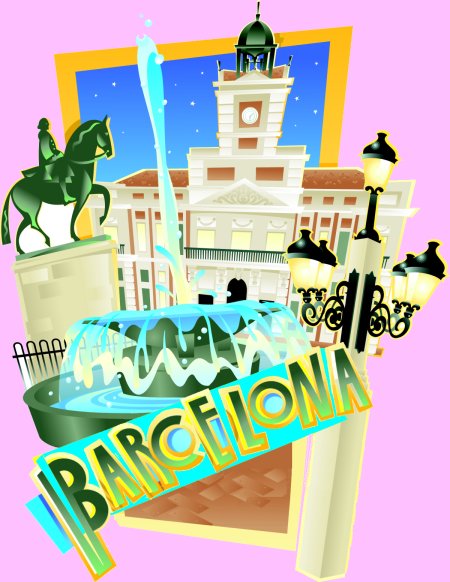 |
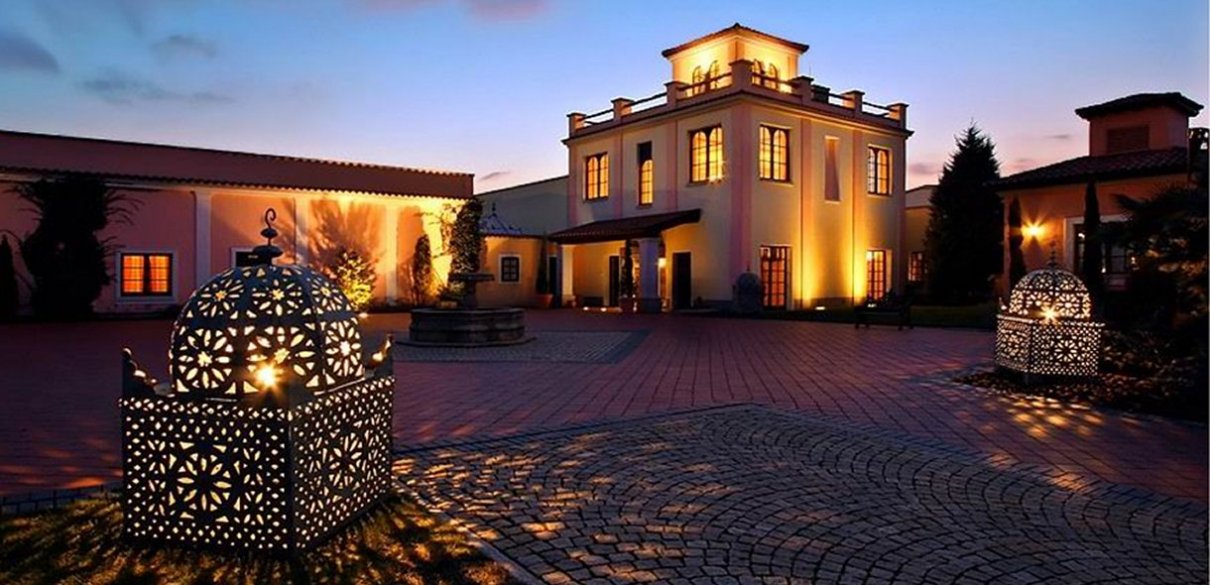 |
|
|
|
|
ABOUT
THE SSQQ 2009 BARCELONA CRUISE
|
MARLA ARCHER'S NOTE:
At our dinner table
during our
2008 Italy-Greece Trip, the favorite topic of conversation was where we wanted to
go next year
in 2009.
Over the course of our trip, the
consensus was strongly in favor of going to Barcelona
and making the Magic Triangle Trip across the Western
Mediterranean Sea.
Due to an odd arrangement of dates in 2009, the studio is
going to be closed for seven days near the
end of September. We have never taken a
week off in September before in thirty years, so this is a
peculiar circumstance (one reason is that instead of 28 days
of classes in December, we will only have
25 days of classes).
The point is that this is the perfect opportunity for the
studio to take a cruise! No student has to miss a class and no teacher has
to find a substitute. Instead we are all going to Spain,
Italy, and France! We
will set sail on September 27th aboard
The Voyager of the Seas,
one of
Royal Caribbean’s finest ships.
It should be pretty easy to wrap your mind
around the incredible highlights of this
trip - the Leaning Tower of Pisa, Vesuvius
and Pompeii, the stunning architecture of
Barcelona, the marvelous museums and ruins
of Rome, the museums of Florence complete
with Renaissance paintings and
Michelangelo's David, the casinos of Monaco,
the fabulous beaches of Nice, plus all the
incredible shorelines of Northern Italy and
Southern France.
What better way to explore this part of the
world than sharing the adventure with all your friends.
Where else can you combine so much history, natural beauty, rich culture and tradition,
all
the while dancing your way across the magnificent Mediterranean
Sea?
We are
visiting the birthplace of the Renaissance. There is so much to see
that you will go crazy having to choose one exciting
destination over another.
Will it be a trip to explore ancient
ruins or an expedition to
witness spectacular mountain vistas and enjoy the
compelling natural beauty?
Or will it be a chance to view
the
rich
architectural and historical heritage,
or just visit one of the many stunning
beaches? Will you make a trip to Pompeii or visit
the exotic Isle of Capri? And can you
possible see all of Rome in a day (no, but
that won't stop you from trying!)
Don't worry, whatever you choose, you can't miss!!
|
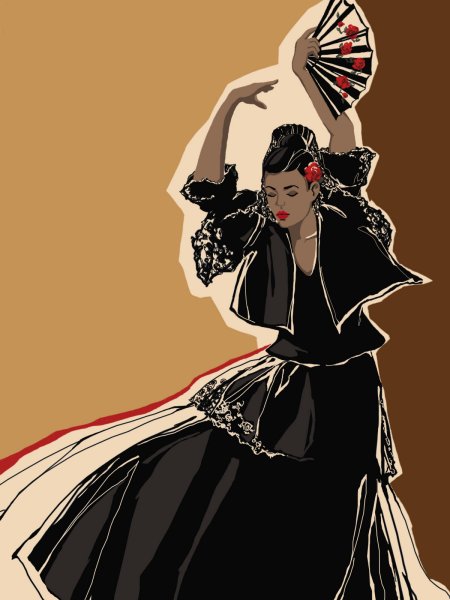 |
|
|
Barcelona,
Spain |
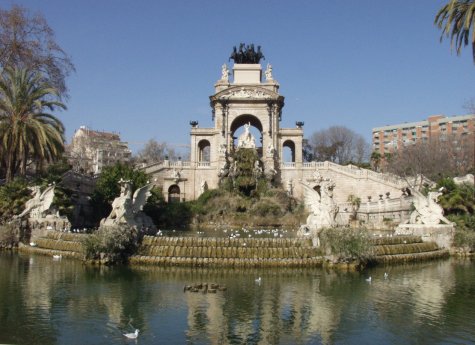
Barcelona
Parc de la Ciutadella |
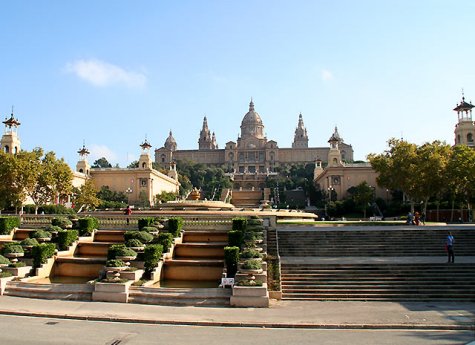
Barcelona Architecture |
|
|
Barcelona,
Spain |
Day One |
Our cruise departs
on Sunday from
Barcelona, Spain at
7:00 pm
in the evening. Why not come a day or two early
to explore Barcelona, Spain's most
stylish and
dynamic city
in even greater depth.
Barcelona is located
in the northeastern part of the country, 90 miles south of
the French border. People from all around the world enjoy
visiting this city for its individuality, cultural interest
and physical beauty. When Hans Christian Andersen visited in
1862, he remarked that Barcelona was the "Paris of Spain."
You're likely to agree. The city is a major cultural center
with a fascinating history. Everywhere are archives,
libraries, museums and buildings of interest - plus superb
examples of modernist and Art Nouveau décor and the unique
architecture of Antoni Guadi.
Antoni Guadi was a
unique, universal artist who ahead of his time. He was able
to invent a whole new world of fascinating shapes and colors
through his architecture. His most famous works such as the
Sagrada Familia Church, Gull Park, Casa Mila House or “El
Capriccio”.
Everyone who stands
before one of Gaudí’s works has the same sensation: the
structures take on shapes from nature and their beauty is
all consuming. Gaudí was one of the great representatives of
Modernism and he revolutionized the canons of architecture.
La Sagrada Familia is
one of Gaudi's most famous works in Barcelona. It's a giant
temple that has been under construction since 1882 (that's
not a typing error!) and it's not expected to be completed
for between 30 to 80 years (time for completion varies
depending on different sources of information.) Controversy
surrounds the building of the Sagrada Familia. Today new
construction materials are being used which, some feel,
Gaudi himself would not have used. When you visit the
building you will see the contrast in the stone color
between the front and back of the building. Also the actual
style of construction appears somewhat different between the
new and old parts of the building. Gaudi
played an active role in directing the construction of the
Sagrada Familia until his death in 1926. He would often
request that work be modified and adjusted until it was
exactly what he had in mind. However today, because of the
nature of the existing designs, his work is partly open to
interpretation. Interpretation of the ordinal designs by
present day architects is particularly challenging because
the actual construction stones are irregularly shaped. The
building is still under construction so be prepared to see a
lot of work continuing when you visit. However this in
itself is interesting, especially if you visit the museum
inside the building. There you will see the stonemasons at
work carving stones to be used in the building. Regardless
of all the controversy surrounding the Sagrada Familia
it is a truly magnificent building and an
absolute must-see
when you visit Barcelona.
Another must-see creation of Gaudi is Park Guell.
Park Gull seems as if it were taken from the pages of a
fairytale: strange, eccentric, even dream-like, but
undeniably beautiful. A stroll through the park will awaken
even the sleepiest imaginations. The peculiar shapes and
daring color combinations mixed in with the park’s
vegetation create a unique world to which visitors feel
irresistibly drawn.
Every corner of the park
displays the architect’s passion for nature’s forms: Gaudí
wanted human intervention in this forest to blend in with
the landscape, to complement it, and he certainly achieved
this. Snails, mushrooms, leaves, flowers, tree trunks and
elephants appear constantly in the mosaics and in the
architectural forms. Even the bell in the chimney of the
concierge’s house is shaped like an inverted mushroom.
The original idea for Park Guell was conceived in 1900, when
Eusebi Gull purchased land on the mountain of Carmel, at
that time on the outskirts of Barcelona to site a
development in which he put Gaudí in charge. The idea was to
copy the English “garden city” model (thus the word “park”),
and build a few homes in idyllic surroundings with wealthy
people in mind who wanted to get away from the crowded
streets and insalubrious life of the city. Three kilometers
of paths were built along with a plaza, stairways, the
concierges’ pavilion and a model house to tempt potential
residents. After 14 years, and seeing that the development
was a commercial failure, it was abandoned and donated to
the city council, which then converted it into a public
park.
Be sure to make a visit to the Parc de la Ciutadella.
The Cascada is one of Barcelona's
most remarkable sites. Fontseré designed the monumental
fountain and artificial lake, located in the grounds of the
Parc de la Ciutadella, in 1875. Both the cascade and the
lake were intended to camouflage a huge water deposit in the
central section of the waterfall, which can be reached by
two flanking symmetrical stairways. Curiously, Gaudí worked
on this project as a young architectural student.
A stroll down Las Ramblas is an absolute must do!
The word Rambla, derived from the Arabic word ‘ramla’,
serves as a reminder that in earlier times, the street was a
gully that ran parallel to the medieval wall, and carried
rainwater down to the sea. Now, Las Ramblas is Spain’s most
famous street, a boulevard lined with trees, which is almost
2km long and is dotted with hotels, cafes, restaurants, and
news stands. It stretches from Placa de Catalunya, a main
square full of shops, restaurants, and banks, located at the
centre of the city, down to the monument of Columbus on the
waterfront.
The
avenue is broken up into five sections, each with its own
name and characteristics. The first one is La Rambla de
Canaletes, which was named after the fountain Font de les
Canaletes. Legend says that whomever drinks from this
fountain will forever keep returning to Barcelona.
The next area is named
after the Estudi General (university) and is called La
Rambla dels Estudis. But some also call it La Rambla dels
Ocells (avenue of the birds), because of its many places
selling birds and small animals.
Next is La Rambla de les
Flors, where you can buy all kinds of flowers. This is also
where you find the century-old Boqueria Market. Inside this
market you can find the freshest produce, meat, fish, and
dried fruits.
At the seafront is La Rambla de Mar
where you can find the beach, an aquarium, restaurants,
movie theatres and popular nightclubs.
The Euro, the currency of the European Union is the official
currency in our ports.
Many stores and restaurants accept major credit cards, which
usually offer a good exchange rate. When shopping
remember there is a value-added
tax to most purchases.
Depending upon the size of our group, we will have our SSQQ
Welcome Aboard Cocktail party this evening. Meet your fellow
SSQQ Cruise passengers and enjoy unlimited cocktails and
dance to your favorite tunes as we sail along
the Western Mediterranean coastline.
|
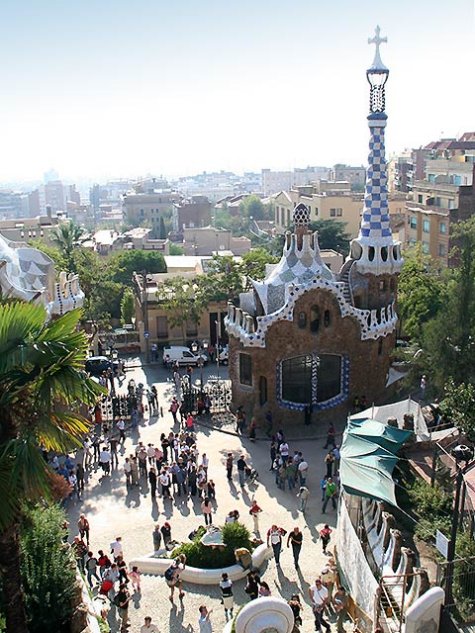

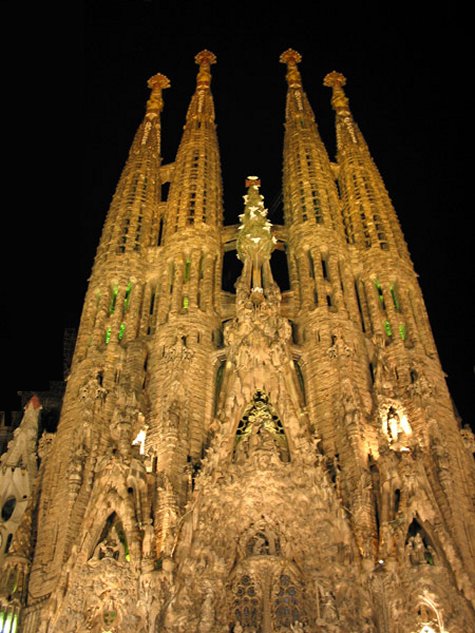
|
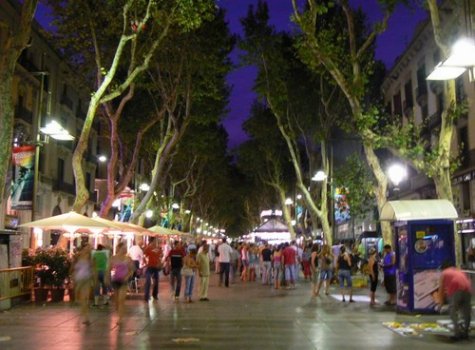 |
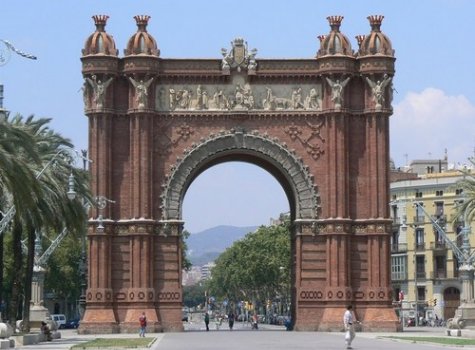 |
|
Naples and the Isle of Capri, Italy |
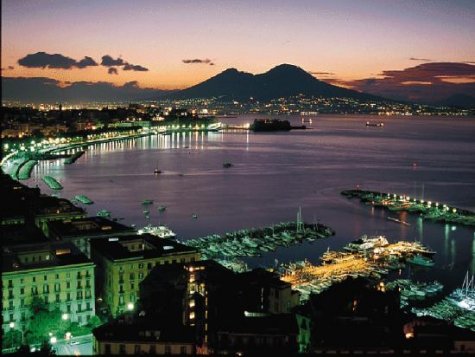
Naples |
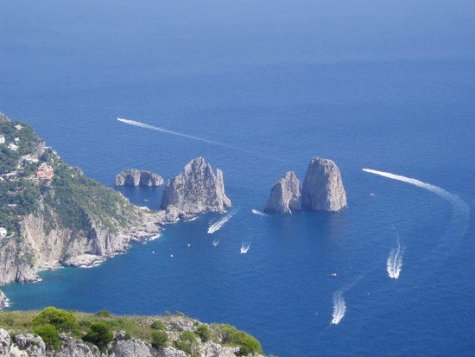
Naples |
|
|
Naples and the Isle
of Capri |
Day Three |
We
arrive at Naples at
7:00 am
on Tuesday.
Naples is not
only picturesque, it's also one of the world's greatest
cultural centers, filled with extraordinary works of art and
architecture in the classical Greek and Roman styles.
It is the third most-populated
city in Italy and the biggest city in Southern Italy. Its
name comes from the Greek Neapolis meaning new city.
Its close proximity to many interesting sites, such as
Pompeii and the Bay of Naples, makes it a good base for
exploring the area. Naples is a lively and vibrant city,
full of wonderful historical and artistic treasures and
narrow, and winding streets with small shops.
Naples is in the region of Campania in Southern Italy, about
2-hours south of Rome. It sits on the coast on the northern
edge of the Bay of Naples, one of the most beautiful bays in
Italy. Its harbor is the most important port in Southern
Italy.
Pizza, one of Italy's most famous foods, originated in
Naples and pizza is taken very seriously here. You'll find
lots of great pizza places but be sure you look for one with
a wood-burning oven! Spaghetti also became popular in Naples
and today the best is with clams or mussels. Seafood is
abundant and very good in Naples, too.
Top attractions in Naples include the National Archaelogical
Museum, Duomo, Spaccanapoli district, shopping, the
harbor, castles, and other museums and of course a visit to
Pompeii.
The National Archaeological Museum of Naples, Museo
Archeologico Nazionale di Napoli, has one of the world's
best collections of Greek and Roman antiquities, including
mosaics, sculptures, gems, glass and silver, and a
collection of Roman erotica from Pompeii. Many of the
objects come from excavations at Pompeii, Herculaneum, and
nearby archaeological sites. The Naples archaeological
museum is one of Italy's top archeology museums and a Naples
must-see site. Highlights include:
Mosaics -
Covering the period from two centuries BC until the eruption
of Vesuvius in 79 AD, most of the mosaics are parts of
floors or walls from Pompeii, Herculaneum, and Stabiae. many
have figures from Greek paintings. The most well-known are
the mosaics from the House of the Faun in Pompeii.
Secret Cabinet - This room was created in the early
1800's to house the museum's many sexual items. It was
closed for many years but reopened in 2000. Visitors must be
at least 11 years old.
Frescoes - Most of the frescoes come from walls in
Pompeii. Covering a period of about two centuries, the
frescoes are excellent examples of Roman painting. They
cover a variety of themes, including mythological,
landscapes, and scenes of daily life.
Temple of Isis- A special exhibit holds wall painting
removed from the temple of Isis in Pompeii as well as
artifacts from the temple.
Pompeii Model - Made in the 19th century, the model
of Pompeii is very detailed and helps the visitor visualize
what it looked like before the eruption.
Sculptures - The museum has a huge collection of
Greek and Roman sculptures, many of them Greek and Roman.
Coins and Metals - Six rooms containing more than
200,000 coins and medals from Ancient Greece, Rome, medieval
times, and the Bourbon era.
While you’re in the area, you’ll want to visit Pompeii, one
of the most famous excavation sites in the world. A
thriving city 1900 years ago, it was devastated by the
eruption of Mount Vesusvius in 79 A.D. when 30 feet of
volcanic ash and pumice stone cover it. The ruined city of
Pompeii, now dug out from the layers of dried lava that once
swept through it, brings to light the life of 19 centuries
ago and has sparked the imagination of the world.
Numerous myths have
surrounded Pompeii, one of which is that a completely intact
city was rediscovered. Actually, the Pompeians (that is,
those who escaped) returned to their city when the ashes had
cooled and removed some of the most precious treasures from
the resort. But they left plenty behind to be uncovered at a
later date and carted off to museums throughout Europe and
America.
After a long medieval sleep, Pompeii was again brought to
life in the late 16th century, quite by accident, by
architect Domenico Fontana. However, it was in the mid-18th
century that large-scale excavations were launched. Somebody
once remarked that Pompeii's second tragedy was its
rediscovery, that it really should have been left to slumber
for another century or two, when it might have been better
excavated and maintained.
Pompeii is
the most important classical archeological site in Europe.
Its wealth of monumental buildings is unmatched, as is its
collection of mosaics and wall-paintings. But its
architecture and art didn’t exist in a void; they were the
framework for a thriving commercial town where 20,000 people
lived, traded, ate, drank, worshipped and frequented
brothels.
Be sure to look for The Duomo. It is a 13th
century Gothic cathedral dedicated to Naple's patron saint,
San Gennaro. A huge festival is held when a vial of
his blood is taken out of its storage place in hopes that it
will liquefy. On one side of the duomo is the 4th century
Basilica Santa Restituta (the oldest church in Naples)
with columns believed to be from the Temple of Apollo, good
ceiling frescoes, and archaeological remains from the Greeks
to the middle ages. The 5th century baptistery has good 14th
century Byzantine-style mosaics.
Spaccanapoli is one of the main streets crossing
Naples and is the heart of the historic center. Teeming with
people, the street holds many interesting churches, shops,
and other buildings. The Spaccanapoli district is a
string of narrow, winding streets and is mainly a pedestrian
zone so its a fun place to wander around. Via San Biagio
dei Librai, in Spaccanopoli, has some of the best
antiquarian book dealers in Italy, terracotta religous and
nativity figurines, and a doll hospital. Via San Gregorio
Armeno is famous for its nativity workshops.
READ MARLA'S
SPECIAL STORY ON THE ISLE OF CAPRI
|
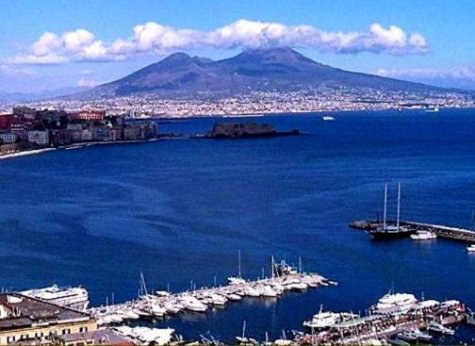
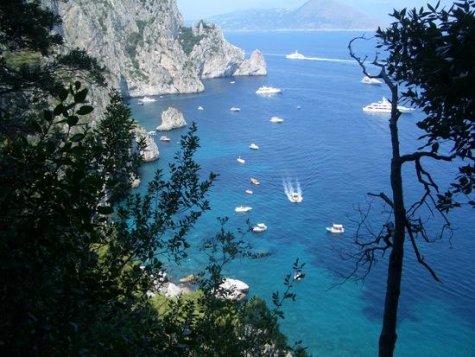
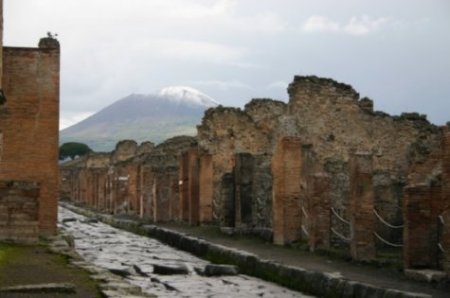
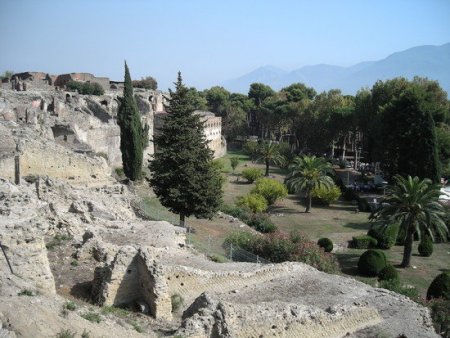
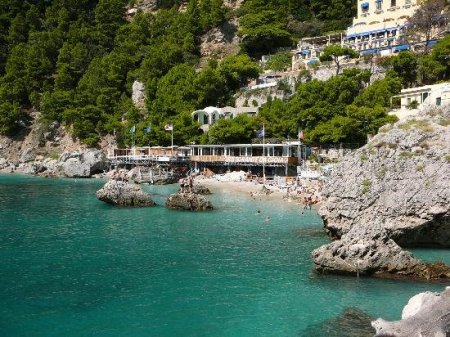 |
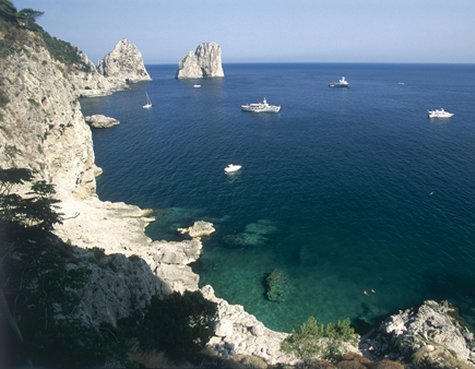
Naples Coastline |
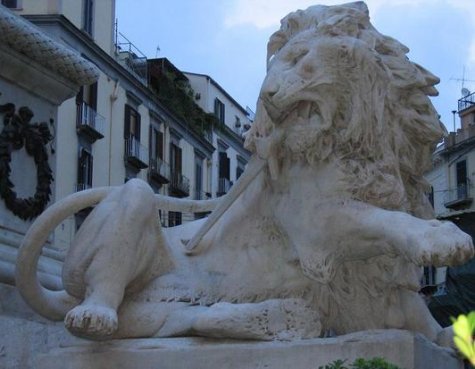
Naples Sculpture |
|
|
Rome, Italy |
|
|
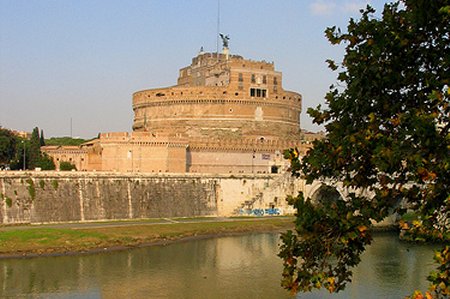
Castle Saint Angelo |
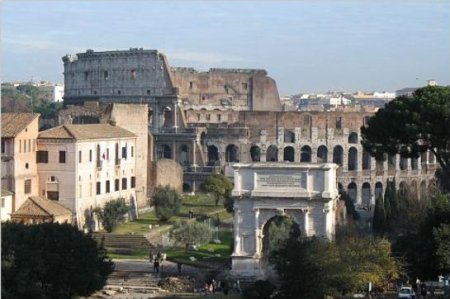
The Roman Coliseum |
|
|
Rome, Italy |
Day Four |
Whether it's the Forum, the Sistine Chapel, the Pantheon or
St. Peter's Basilica that sparks your interest and
intellect, Rome is home to a lifetime's worth of historical,
architectural and spiritual sites. Depending on traffic, the
drive from Civitavecchia to Rome takes approximately an hour
and a half.
Experience the history of Rome as you wander around the
Colosseum, one of the most important monuments of ancient
Rome and the Roman forum. A masterpiece of
classical architecture, the Colosseum is an enormous
amphitheater where gladiators, Christians and wild beasts
once battled to the death in front of 55,000 spectators.
Upon completion, spectacular 100-day celebrations were
organized as part of the opening ceremony in 72 AD. Its name
is believed to come from Nero's enormous statue of Colossus
that stood close by. The admission charges are about EUR10.
The Forum was
designed to be the centre of social, political and economic
life in the city. The innumerable remains include the
well-conserved triumphal arch of Emperor Septimius Severus,
with reliefs depicting his victories and the base of the
Temple of Saturn with its eight columns and their splendid
Ionic capitals. The 'Rostrum' is the famous platform from
which Mark Antony gave his oration in Shakespeare's play
after Julius Caesar's assassination. The platform became the
setting for many important events in Rome's history. It was
named the 'rostrum' after the bows of the ships that form
the decorative motif. The Temple of Vesta was the home of
the Vestal Virgins, charged with
keeping the sacred flame alight. The circular foundations
still remain, near to a garden in which traces of the House
of the Vestal Virgins can still be seen. The Basilica of
Constantine and Massentius was used as the court, and the
three remaining barrel-vaulted naves give an idea of its
gigantic structure. The Arch of Titus celebrates victories
in Judea, and in the reliefs you can see the spoils of war,
including an altar and a seven-armed chandelier. Admission
is free; guide tours in English cost EUR3.20
Visit the Vatican Museum, where you can walk through the
many rooms that house the largest art collection in the
world. The
Vatican is among the most important historical sites in the
world. The seat of the Holy Roman Catholic Church, The
Vatican is also the home of the Pope. As the smallest state
in the world, the Vatican has figured in key events
throughout history. Occupying about one half kilometer of
Rome, The Vatican is further significant because of its
fabulous architecture, religious, and artistic treasures. It
was Pope Julius II della Rovere in the 16th century who
commissioned Michelangelo to paint the history of creation
on the ceiling of the Sistine Chapel. Among countless other
notable events in the history of this important city are the
convening of the College of Cardinals, at the death of a
reigning Pontiff, for the purposes of electing a new Pope.
No visit to Rome is complete without an excursion to The
Vatican, a place so steeped in history and tradition that
you will never forget it.
Travel
through the magnificent St. Peter’s Basilica, the largest
church in the world. . Construction began in 1452 on the
site where St. Peter was buried and took over 100 years to
build. It rests on 800 pillars and is littered with 44
altars.
During the next
200 years, such famous masters as Bramante, Michelangelo,
Raphael and Bernini worked on its design and created an
unparalleled masterpiece. View Michelangelo's "Pieta" and
the 85-foot-high Bernini Pulpit. Admire one of
the many masterpieces created by Michelangelo, the famous
statue of Moses. This majestic bearded figure is depicted
holding the tablets of the Ten Commandments.
If this is your first visit
to Rome time, you must take in the Sistine Chapel. It
is considered a masterpiece of Renaissance art.
Dominating the chapel is Michelangelo’s ceiling paining of
the “Creation of the World.”. The Sistine Chapel
receives 50 million monthly visitors. The Chapel was
built somewhere between 1477 and 1481 by Pope Sixtus IV.
From 1480 to 1483, famous artists of Renaissance, such as
Botticelli, Perugino, and Ghirlandaio, decorated the walls.
After twenty years, Julius II commissioned Michelangelo to
decorate the ceiling in 1508. Today, after the restoration,
tourists can visit the chapel and see Michelangelo's “Last
Judgment.” You will invariably find the Sistine Chapel
crowded with hundreds of tourists, so be prepared. The best
way to see it is to go to the Vatican Museums early, so that
you're among the first in line when they open. Silence
should be observed and photography is not prohibited.
The Pantheon was commissioned by Marcus Agrippa, restored by
Domitian, and subsequently rebuilt by Hadrian (who added the
dome) before being turned into a church in the early 7th
century by Pope Boniface IV. The building's sole source of
light is the opening at the dome's apex (the oculus);
according to popular legend, this formed the base for the
bronze pinecone that is now in the Vatican's 'Pigna'
courtyard, where it is used as a fountain. Many famous
Italians are buried in the Pantheon, including Renaissance
painter Raphael and King Vittorio Emanuele I.
No visit to Rome can be complete without a stop at the
Fontana di Trevi.
Tradition has it that throwing a coin over your left
shoulder into the fountain guarantees a swift return to the
world's most beautiful city. Anita Ekberg's dip in it was
immortalized in Fellini's 'La Dolce Vita', and Italian actor
Toto even sold it to an American, passing himself off as its
owner. Earlier it was the setting for the award-winning
"Three Coins in the Fountain" motion picture, ensuring its
popularity worldwide. Designed by Nicola Salvi for Pope
Clemente XII, it was completed in the second half of the
1700s. The statues in the centre represent Neptune supported
by Tritons on either side while rococo-style Poli Palace
provides the perfect backdrop.
Marla's Note:
We had
the pleasure of visiting Rome in 2008. Rome was our
absolute favorite stop of the entire trip. Please read
Rick's write-up about our adventures:
Rome
2008
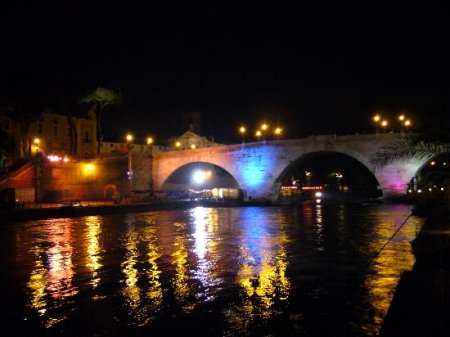
Trastavere at Night
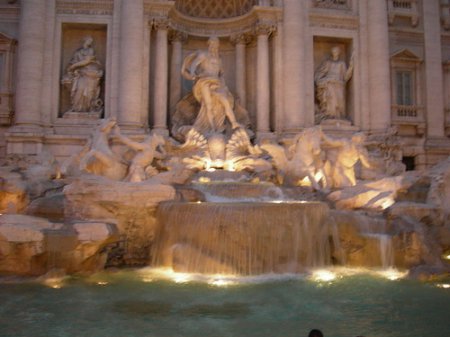
Trevi Fountain
|
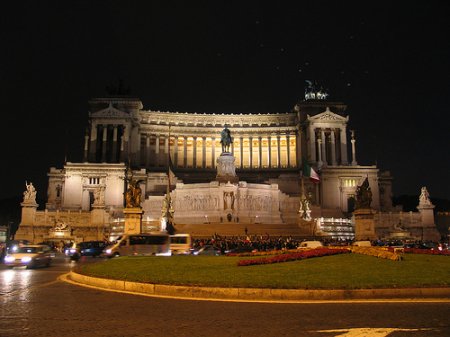
Victor Emanuel Monument
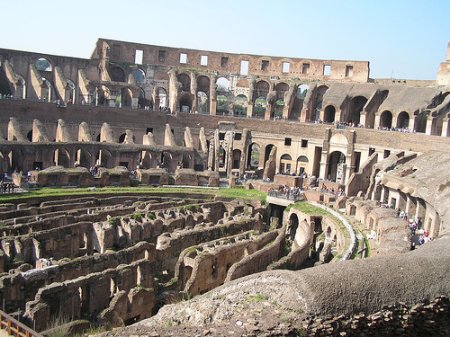
Roman
Coliseum, One the new Wonders of the World
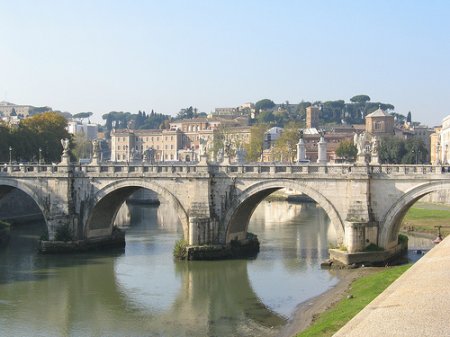
Castle
Saint Angelo
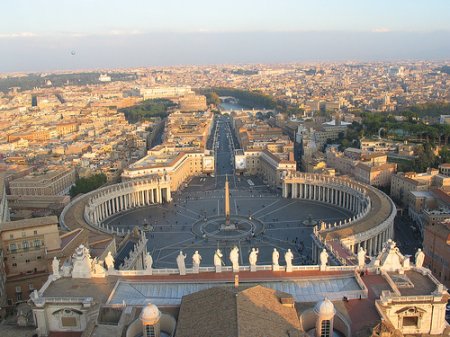
View
from the Basilica
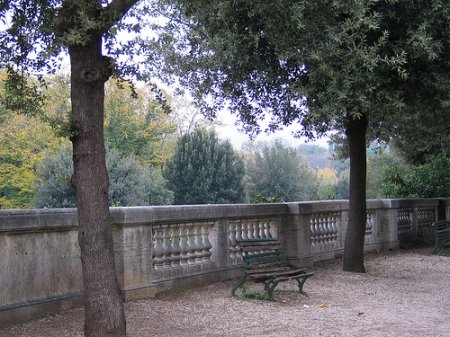
Villa
Borghese Grounds
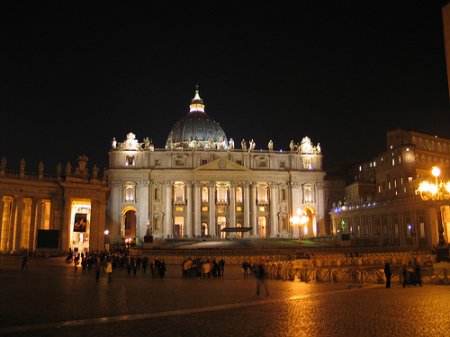
St
Peter's Basilica
|
|
|
|
|
Florence and Pisa in
Italy |
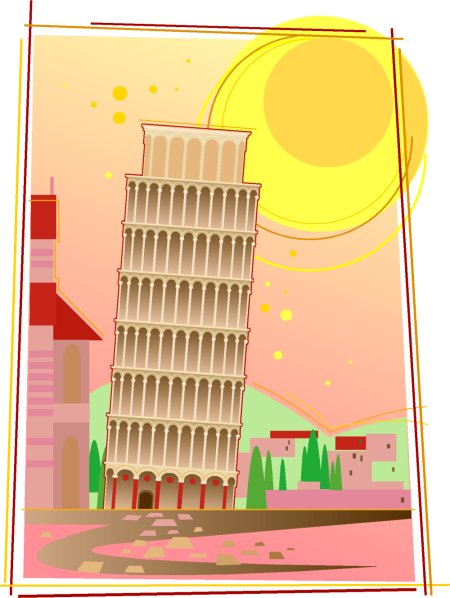 |
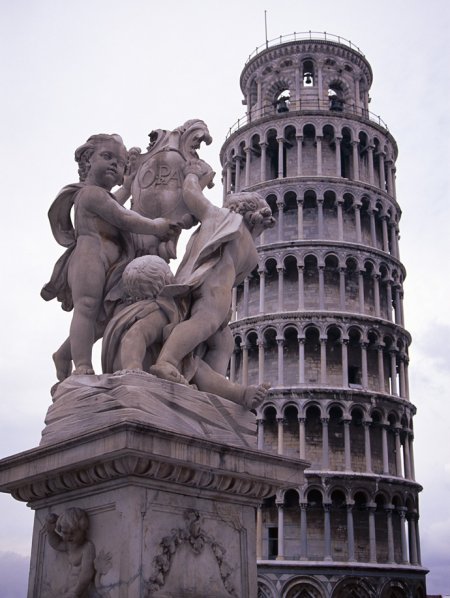 |
|
|
Florence and Pisa
|
Day Five |
Florence is
the Renaissance city -- home to Michelangelo's
David, Botticelli's Birth of Venus, and
Raphael's Madonnas. It's where Fra' Angelico painted
delicate Annunciations in bright primary
colors and Giotto frescoed monks wailing over the
Death of St. Francis. The city is so dense in
art, history, and culture that even a short visit
can wear out the best of us. Take a hint from that
great pragmatist Mark Twain, who, after
acknowledging the genius of Michelangelo, said "I do
not want Michelangelo for breakfast -- for luncheon
-- for dinner -- for tea -- for supper -- for
between meals. I like a change occasionally."
Don't necessarily
pass up the Uffizi or take a rain check on David
and the Accademia, but do take the time to enjoy the
simple pleasures of Florence -- wander the medieval
streets in Dante's old neighborhood, sip a
cappuccino on Piazza della Signoria and
people-watch, haggle for a leather jacket at the
street market around San Lorenzo, or immerse
yourself in the greenery of the Boboli Gardens.
Florence’s lofty domes and sacred art will make your
senses reel
The cultural and
historical impact of Florence (or Firenze) is
overwhelming. Close up, however, the city is one of
Italy’s most atmospheric and pleasant, retaining a
strong resemblance to the small late-medieval centre
that contributed so much to the artistic and
political development of Europe.
Its striking
buildings, formidable galleries and treasure-crammed
churches attest to the Florentine love of display.
Even long after it had set on the political and
economic horizon, Florence upheld its elegant
appearance: its skyline, all russet rooftops and
lofty domes, is indeed picturesque.
Florence's best park is the Medici grand dukes' old
backyard to the Pitti Palace, the Giardino Boboli.
Less scenic, but free and more jogger-friendly, is
the Parco della Cascine along the Arno at the
west end of the historic center. Originally a wild
delta of land where the Arno and Mugnone rivers met,
the area later became a Medici hunting reserve and
eventually a pasture for the grand duke's milk cows.
Today, the Cascine is home to tennis courts, pools,
a horse racetrack, and some odd late-18th- and
early-19th-century features like an incongruous
pyramid and funky neoclassical fountains. There's a
flea market here every Tuesday morning. Though
perfectly safe in the daylight, this park becomes a
den of thieves and a hangout for heroin addicts
after dark, as do most sections of the Arno's banks,
so steer clear.
Of course you must see the Quintessential Man,
David: Michelangelo's David in the
Galleria dell'Accademia is the perfect Renaissance
nude, a masterpiece of sculpture, an icon of
homosexual camp, and symbol of Italy itself.
Be sure not to miss seeing Masterpieces at the
Gallerie degli Uffizi, too: The Uffizi is one of the
world's great museums, and the single best
introduction to Renaissance painting, with works by
Giotto, Masaccio, Paolo Uccello, Sandro Botticelli,
Leonardo da Vinci, Perugino, Michelangelo, Raphael
Sanzio, Titian, Caravaggio, and the list goes on.
The museum is deceptively small. What looks like a
small stretch of gallery space can easily gobble up
half a day -- many rooms suffer the fate of
containing nothing but masterpieces. Don't miss
Sandro Botticelli's Birth of Venus. The
goddess of love is born from the sea; a beauty drawn
in the flowing lines and limpid grace of one of the
most elegant masters of the early Renaissance.
Strolling through the Piazza della Signoria: The
monumental heart of Florence (and Tuscany's most
famous square) is an open-air museum of sculpture,
dominated by Michelangelo's David (a copy of the
original, which used to stand here). The powerful
mass of the Palazzo Vecchio dominates one end of the
square; another is defined by the 14th-century
Loggia della Signoria, filled with ancient and
Renaissance statues (the most celebrated being
Bevenuto Cellini's Perseus holding the severed head
of Medusa).
Or
add a side-trip to the city of Pisa.
Pisa,
located in western Tuscany, is known throughout the
world for its famous Leaning Tower, but there is so
much more to Pisa than just this striking landmark.
The ecclesiastical city of Pisa began life as a
seaside settlement around 3,000 years ago and was
first laid out in the mid-eleventh century. Pisa is
crammed full of wonderful, historical monuments and
buildings dating back many hundreds of years and
much of Pisa has retained its medieval appearance.
Pisa is also known for its excellent university,
which was established in 1343 and has become one of
Italy's top schools.
The leaning tower of Pisa was commenced in 1152, and
was not finished until the fourteenth century.
The cathedral to which this belongs was erected to
celebrate a triumph of the Pisans in the harbor of
Paleromo in 1063, when allied with the Normans to
drive the Saracens out of Sicily. It is a
circular building, one hundred feet in diameter and
179 feet in extreme height, and has fine mosaic
pavements, elaborately carved columns, and numerous
bas-reliefs. The building is made from white
marble. The tower is divided into eight
stories, each having an outside gallery of seven
feet projection. The top most story overhangs
the base by about sixteen feet, although the center
of gravity is still ten feet with the base.
The building is perfectly safe. It has been
supposed that the inclination was intentional,
however the tower leans more likey because the
foundation has sunk. The defective foundation
probably became perceptible before the tower had
reached about one-half its height because it looks
like there was an effort to restore the tower to a
perpendicular position. You can see that the
walls are strengthened with iron bars at this point.
READ RICK'S
SPECIAL STORY ON FLORENCE
|
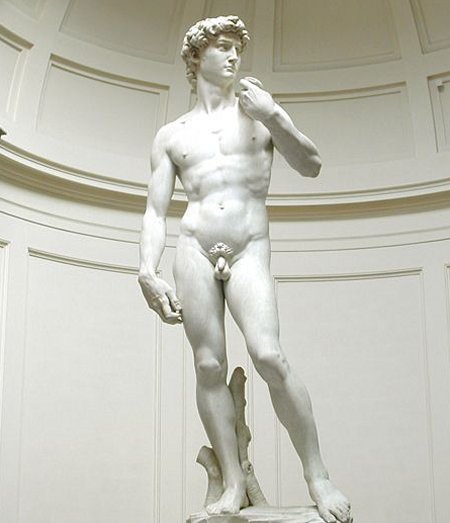
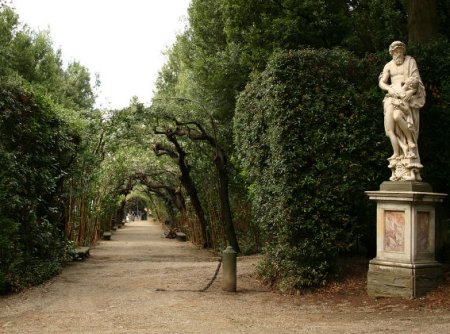
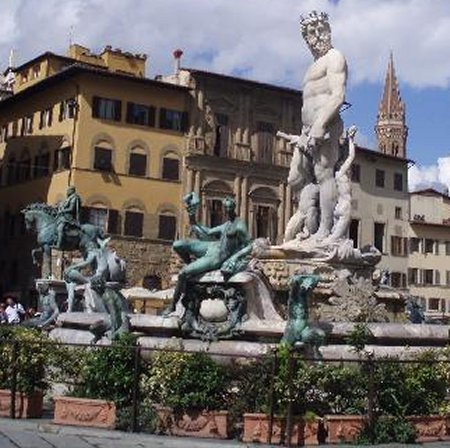 |
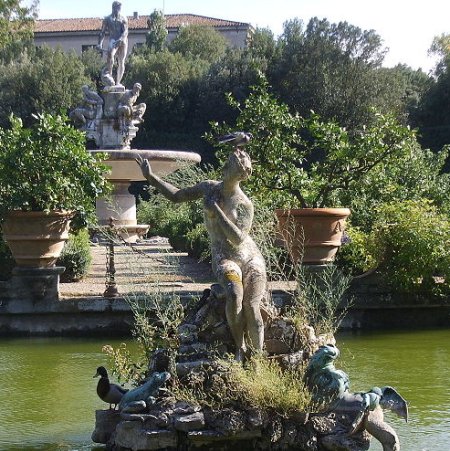
Florence
|
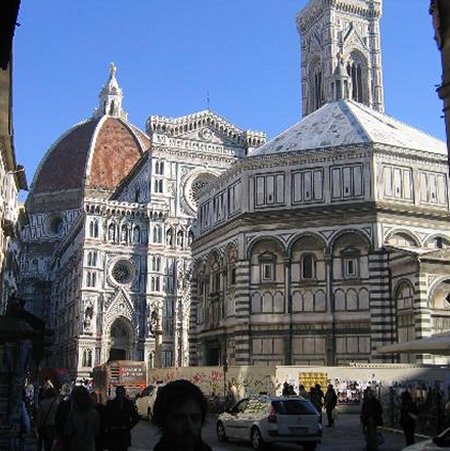
El Duomo
|
|
|
|
Nice, France
and the Casinos of Monaco |
|
|
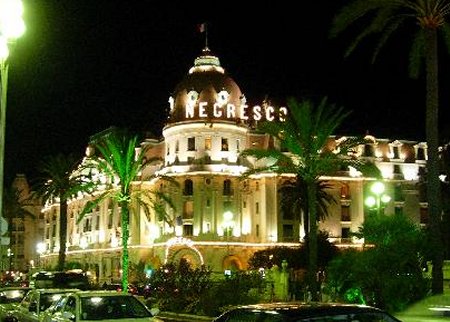
Nice |
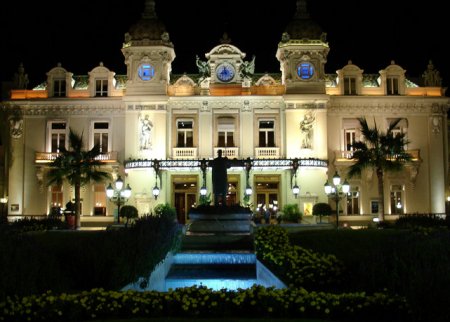
Monaco |
|
Nice, France and
Monaco |
Day Six |
Villefranche is the gateway to
the one-of-a-kind French Riviera, home to Monte Carlo,
Cannes and Nice. Shaded by jagged mountains touching
deep blue shores, Villefranche offers sunny beaches,
sophisticated resort cities, quaint red-roofed villages
and spectacular views.
While Villefranche is lovely, it’s truly remarkable for
what surrounds it. Be sure to visit some of its
better-known neighbors: Cannes, Nice and Monte Carlo.
These jet setter’s retreats are as remarkable for their
beautiful beaches as the mansions and boutiques that
surround them.
View the Rock
of Monaco, the oldest of Monaco’s four quarters.
The
Rock has always been a coveted possession, from the
beginning of the Massilian colony of Monoïkos, named for
the Ligurian tribes who occupied the area and vied for
control of it; before that, it was a shelter for
primitive populations. The Rock of Monaco was also the
first conquest of the Grimaldi dynasty, the rulers of
the country for more than 700 years, founded when the
Guelf Francois Grimaldi disguised himself as a
Franciscan monk in order to gain entry to the city and
open the gates for his soldiers.
Explore
the vaulted passageways and beautiful façade of Monaco's
Prince's Palace and the Palace Square. Bask in the
unabashed opulence of this palace, decked out in colored
marble and gold plating. The Palace was built as a
Genoese fortress circa 1215. Take in the Throne Room,
where Prince Albert II holds state receptions. In the
Main Courtyard with its horseshoe-shaped, Carrara marble
staircase - three million stones create eye-catching
geometric patterns.
The Palace Guard is always on hand to ensure
security and protect the Prince and his Palace. At
11:55AM daily, watch the colorful changing of the guard.
Visit the Old town with all of its intriguing sights.
The bronze cannons protecting the harbor were Louis
XIV’s gift to Monaco. The houses look medieval and they
are.
Travel along the mountainside roads of the French
Riviera, which offer spectacular views of the small
villages along the coast and the Principality of Monaco.
As you leave Villefranche, you will see the famous Grand
Corniche, which was originally built by Napoleon. Enjoy
a scenic view of Roquebrune Cap Martin near the Italian
border and La Turbie before reaching Monaco.
Try your luck at Monte Carlo's Grand Casino. Browse the
exclusive shops in Casino Square, or sit at a cafe and
do some people watching.
Make a stop at
the charming medieval Village of Eze. Perched on the
cliff 1,400 feet above the Mediterranean, the views are
spectacular as you look back over Beaulieu and
Villefranche.
Of all the perched villages along the Riviera, Eze
remains the most popular with it’s quaint medieval core
and cobblestone streets...Standing alone in the hills,
it appears to have been built like an eagles nest, on a
rocky spike 1400 feet above the Mediterranean. The
strategic skills of the architects and laborers who
built such a place have to be revered.
The village is best
explored on foot, with its narrow cobblestone streets,
many little shops and local artisans.
The Present structure
of the village goes back to the Middle Ages but Eze has
been occupied since the Bronze Age. Even before the
Greek occupation, legend tells of the Phoenicians
building a temple here, and, after the collapse of the
Roman Empire, who held the territory for quite a while,
the area underwent several invasions before it
eventually belonged to Monaco for a long period. It
wasn’t until sometime in the 1860’s that the inhabitants
of Eze voted for annexation to France.
Today Eze is a favorite tourist site. As you walk
through the small archway that leads into the village,
the streets become narrow and more intimate, sometimes
twisting upwards in a series of steps, other times
running smoothly beside carefully restored houses in
small passageways, where you sometimes must shoulder
your way through the tight crowds that arrive often each
day in a never ending stream of buses.
Every house seems
to have it’s own “smart” boutique or artists studio
selling it’s own version of “typical” Eze souvenirs but
don’t be discouraged, there are still a few spots where
you can get away from the crowds and the village can be
enjoyed to it’s utmost. Le Jardin Exotique is such a
spot...An exotic and lushly landscaped garden of exotic
plants and cactus garden that was developed by Louis XIV
which decorates the summit of the village and with those
incredible views of the sea, from any vantage point, it
truly is magnifique!
|
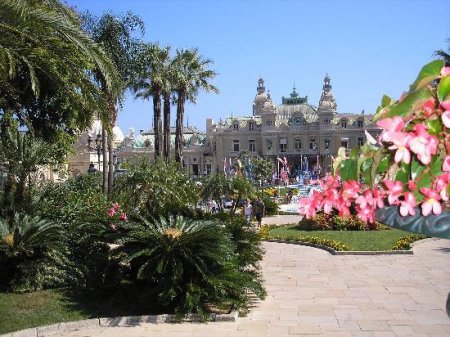
Monaco
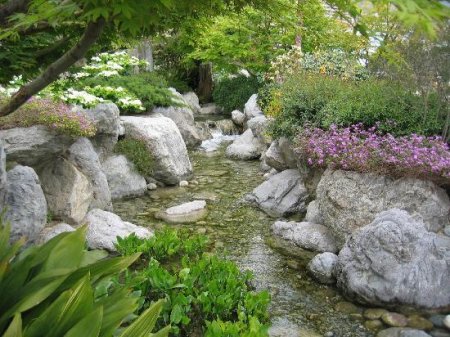
Exotic Gardens

Nice Harbor
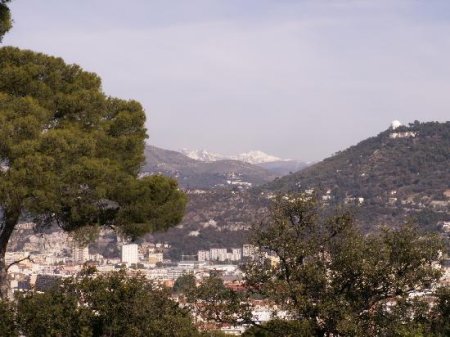
French Alps in
the background of Nice |
|

The Topless
Beaches of Nice (don't expect to see Rick here)
|
|
|
Marseilles, France |

Harbor of
Marseilles |
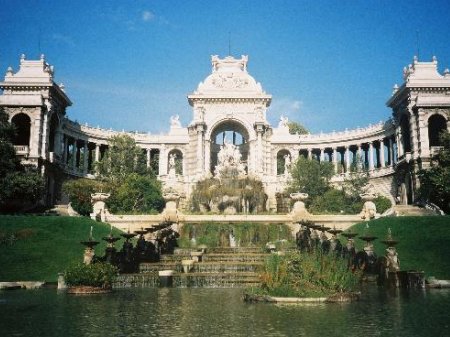
Marseilles Palace |
|
|
Marseilles, France |
Day Seven |
Marseilles has a
soul of its own. The Greek sailors of
Phocaea founded the city in 600 B.C.
This great city is the oldest in France
and surely the most complex.
Second largest city in France and the
largest commercial port, Marseilles, in
the time of the French colonies, was the
gateway to the Mediterranean; Today
Marseilles remains a capitol of southern
Europe, cosmopolitan and exuberant, with
its picturesque old port, its
Bouillabaisse and its folklore.
Difficult to know, Marseilles does not
open itself up to visitors
spontaneously.
The old town ("Panier") and port, the
cliff road high above the sea, the wild
inlets plunging into the deep blue water
for 20 km. to Cassis, this is the
Marseilles of the tourist guide. But the
commercial port, the airport, the oil
industry, the large population all play
an important part in the economic role
of the whole of Provence and complete
the picture of a city rich not only
economically but in culture, art and
science.
To discover its unique character and
beauty, one must leave the center of
town and explore some of the "quartier"
of which there are more than 100. Each
quartier is a little Provencal village
of its own with a church, a playing area
for the game of Boules and the
obligatory plane trees.
For the best view of the city, there's
only one place to go: Notre Dame
de la Garda. Entirely covered in
gold leaf, it towers over Marseille at
an impressive 500 feet tall (154
meters.) Throughout the years, it has
served as a lookout post, a military
zone and a place of worship. One can
climb to 162 m, above sea level to visit
the church of the patron saint of
sailors. One can admire the cliffs the "Estaque"
inspiration to Cezanne or go to Treille
to pay homage to the well-loved
Provencal writer Marcel Panel,
Marseilles can also be visited from the
coast. From the islands "lles de Frioul"
and the Chateau d'If with its legend of
the Count of Monte Cristo, one has a
beautiful view of this ancient maritime
site.
Although in many respects Marseille is
big and sprawling, dirty and slum-like
in many places, much elegance and charm
can be found there as well. The Vieux
Port, the old harbor, is especially
colorful, compensating to an extent for
the dreary industrial dockland nearby.
Marseille has always symbolized danger
and intrigue, and that reputation is
somewhat justified. However, the city is
experiencing a renaissance, and because
it is now so easily reached by train
from Paris, there is much hope for its
economic future. Since the 1970s, a
great deal of Marseille's economy has
revolved around thousands upon thousands
of North and sub-Saharan Africans who
have poured into the city, creating a
lively medley of races and creeds.
One-quarter of the present population of
Marseille is of North African descent.
These Africans have flocked here to find
a better life than what they had in
their own shattered lands.
Marseilles today actually occupies twice
the amount of land space as Paris, and
its age-old problems remain, including a
declining drug industry, smuggling,
corruption (often at the highest
levels), the Mafia, and racial tension.
Unemployment, as always, is on the rise.
But in spite of all these difficulties,
it's a bustling, fascinating city unlike
any other in France.
A city official proclaimed recently
"Marseille is the unbeliever child of
France. It's attached to France, but has
the collective consciousness of an
Italian city-state, like Genoa or
Venice."
|
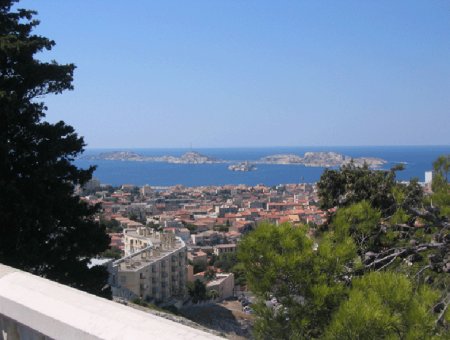
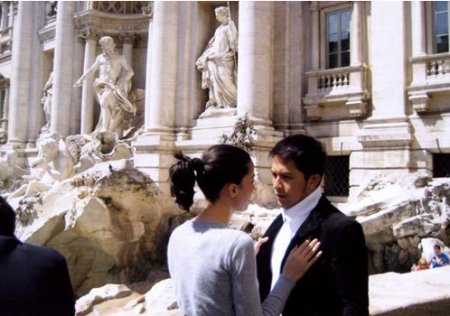
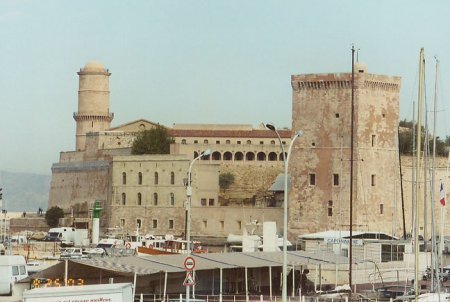
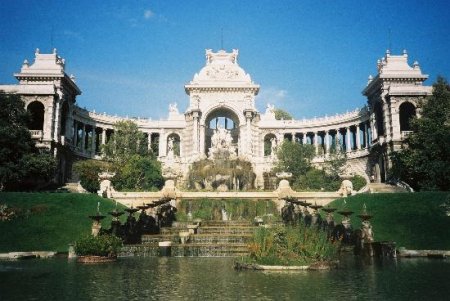
|
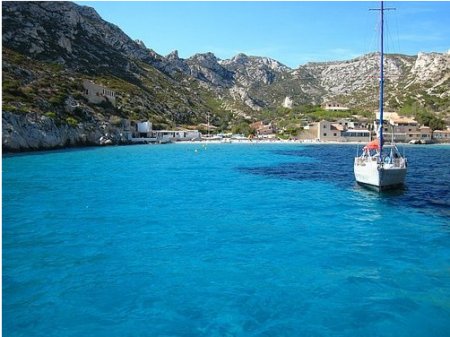 |
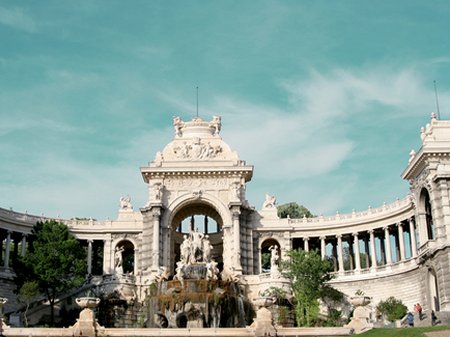 |
|
|
About the
Barcelona 2009 Trip
|
|
|
A
visit to the Mediterranean is on
every person's must-see short list. The
Mediterranean is one of the world's favorite
vacation destinations
The Barcelona Trip will be the 16th SSQQ Cruise Trip.
As always, you have the best of both worlds.
You can be alone with your sweetheart perched on a
terrace overlooking the sea in Capri or you can hang with the group whenever you
wish. Wherever you go, you will always have
friends. We watch out for each other. At
dinner time when you wish to share tales of your
adventures, you won't be talking to strangers, you
will be talking with friends from home.
We chose this week for two reasons. We were
able to get a great rate for this great sailing time
(cooler temps and less children). Also, due
to an unusual alignment of the 2009 holidays, we
will be taking a week off at the end of September.
Since the
studio is closed for a week's vacation, what better
time to go exploring?
Our trip will be aboard Royal Caribbean’s
Voyager of the Seas.
This ship is part of Royal Caribbean's Voyager
Class,
among the biggest vessels
in the world. It is 138,000
tons of fun.
A beautiful wooden dance floor is
featured in a spacious attractive non-smoking
lounge. The ship is so plush even the Disco has a
wooden floor as well. The
Voyager of the Seas sports some of the industry's
most amazing features: a rock-climbing wall,
ice-skating rink, an indoor, mall-like promenade,
basketball court and in-line skating track.
If you
wish to go, here is what you
need to do:
Fill out the registration form and provide a credit card number for your
$250 deposit. All passengers must have a
Western Mediterranean Cruise 2009 registration form on file.
There will be new rules in effect for this cruise.
The first deposit
of $250 per person is due by
January 19th, 2009.
Final payment is due on July 15th.
Please Note:
If you would like a specific cabin type/location not
offered, please call and I will get that rate
quoted.
Contact Marla Archer at 713 862-4428 or e-mail
marla@ssqq.com
with any
further questions.
REGISTRATION FORM
|
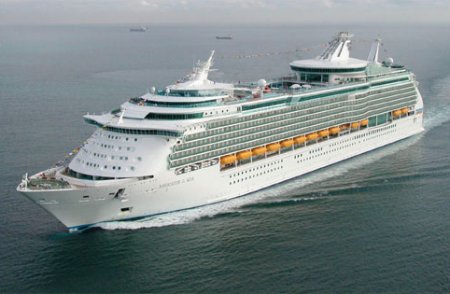
RCCL Voyager of
the Seas
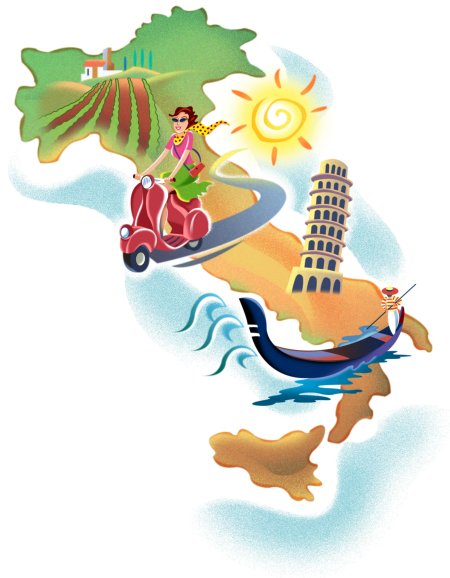
|
|
|
|
|
|
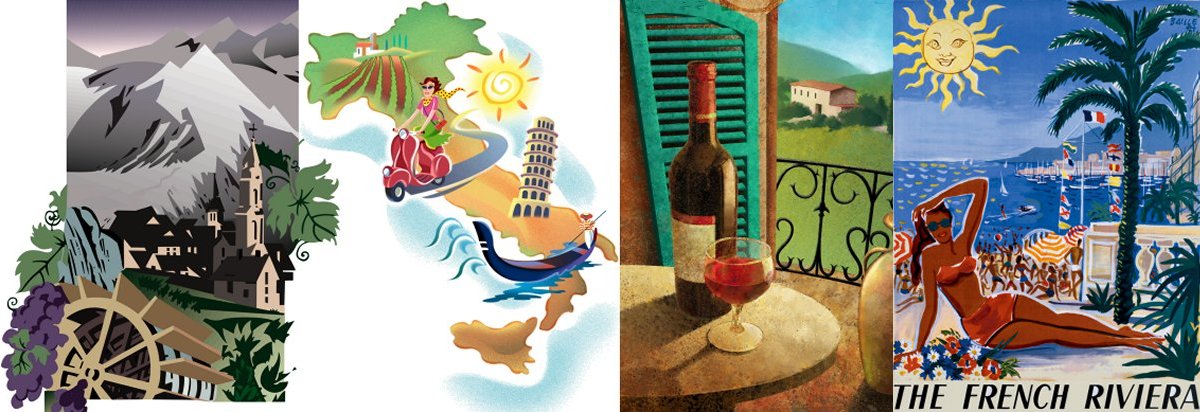 |
Marla's Notes
1. Tour Services in Barcelona referred by Dana LeDoux:
CHRISTIAN BARBANY
Taxi Vip Barcelona
T: 610.78.07.22
F: 93.465.74.88
christian@taxivipbarcelona.com
www.taxivipbarcelona.com
|
 |
2. Tip Reminder from Wendy Weston:
Many European
countries add the tip to the bill. This is common practice
in Spain. So check the bill for an item called servecio (or
svc shortened). If you see that, you have already paid the
tip. It is customary to leave any small change behind or to
add up to 5% if the service was really good.
3. Hotel Recommendations:
Mara's Hotel Suggestion
- contributed by Mara Rivas
Dana's Hotel Suggestion
- contributed by Dana LeDoux
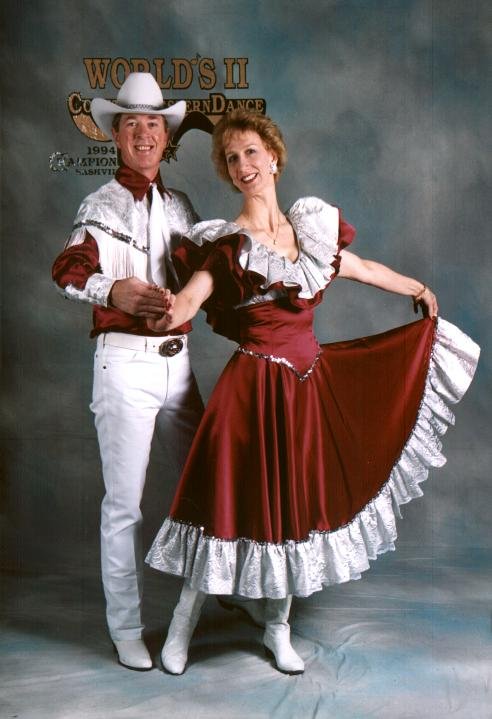 |
4. Trip Summary
(Rick Archer's Note: Patrick Steerman is a former
SSQQ instructor who moved to Atlanta in the late
Nineties. As you will see, Patrick took this
identical cruise last year. I think you will
find his comments very helpful!)
From: Patrick Steerman
Sent: Friday, June 26, 2009 10:17 AM
To: dance@ssqq.com
Subject: Voyager of the Seas Cruise
Rick:
I took the Voyager of the Seas cruise June 7th
through June 14th and had a great time. You made a
good choice when choosing this one. The ship came
out of dry dock during May and it looks great. The
staff is well trained and attentive to all of your
needs. SSQQ will have a great time on this one.
If you are interested, I have posted pictures on an
internet hosting site. The link is as follows:
Patrick Steerman's Barcelona Photo Gallery
Excursions
We took excursions at all ports except Rome. We were
in Rome last year so we just took a bus into Rome
and spent the day. While all of the excursions were
interesting and well planned, Royal Caribbean makes
it easy for those who do not wish to take
excursions. In most cases, buses were available from
the dock to the city for those who wanted to tour on
their own. Some people just took a short trip into
some of the cities which allowed more time for
shipboard activities. Another option is to go to the
internet and arrange a custom excursion - they will
meet you at the dock.
Excursions offered by Royal Caribbean seem (actually
were) fairly expensive but we opted to take these.
When you book an excursion through Royal Caribbean
it is guaranteed. When we arrived late into
Civitavecchia, those who booked their own excursions
were late and the cost was not refunded. Royal
Caribbean refunds the cost if an excursion is missed
and guarantees that you will arrive back at the ship
before it leaves, or they wait on you. In two ports
we had individuals that missed the ship and had to
make their own way to the next port.
|
In Naples, we took the Pompeii, Sorrento and Capri
excursion. We had about 1 ½ hours at Pompeii, a great lunch
in Sorrento, and a ½ hour to look around, and then took a
boat to Capri. Capri is beautiful but looks like a cross
between Carmel, California and Palm Beach, Florida. There
are lots of terribly expensive shops and hotels with not a
lot to do but see the beautiful view (I have posted
pictures), which is great. This was a fairly expensive
excursion.
In Rome we took a bus into the city and were dropped off
near the Vatican and given a place to meet for the return.
It was suppose to be a high speed train but the ship was
delayed getting into port because of a reported case of the
flu. Everyone on the ship was required to fill-out forms and
the Italian officials had to review each form before we
could dock, so the train was replaced with a bus. From the
Vatican we took a bus to Trevi Fountain and then walked to
the Pantheon where we had a great lunch at a place just in
front. From there we walked to Piazza Navone which is one of
the most famous and most beautiful of Rome's many squares. I
believe this was featured in the movie "Demon's & Angels".
In Florence we took the "A Taste of Florence" excursion
which included a bus ride into Florence and a short guided
tour, which includes about an hour or so on your own. It may
have been a better idea to just take a bus into the City and
pick up a guide. Because of limited time, we did not
actually go into any of the sights. We did not go to Pisa.
Several people told us that their excursion stopped by Pisa
for pictures.
Villefranche (Nice) is a "tendered" port requiring a shuttle
boat to the port. We took the Nice, Eze and Monaco excursion
which included a very brief tour of Nice and then visited
Eze, which is a beautiful medieval city and is worth the
trip if you enjoy history. I had been to Monaco and was not
really interested in revisiting it again. It is beautiful
but I believe you can find better things to do. Our
excursion also included the casino at Monte Carlo. The area
is beautiful area but it is just another casino. More time
in Nice would have been good with me.
In Provence (Marseilles) we took the excursion to Les Baux
de Provence which is about an hour north of Marseilles. It
is another beautiful and interesting medieval city in the
area of Provence. For me it was worth the effort. This
excursion dropped us back at the ship in time to take a bus
into the city. We were dropped down by the marina which has
lots of shops and restaurants. I have been on two vacations
to Europe that included stops in Marseilles and for the
second time, the best meal of the entire trip was along the
waterfront in Marseilles.
We spent 1 ½ days in Barcelona before the cruise and 3 days
afterwards. Barcelona is a great destination and I would go
back. Our hotel was in the Gothic area and almost everything
is within walking distance. The airline lost our luggage so
we walked to the ship on the day of the cruise - (luggage
was delivered directly to the ship). The Gothic area is
mostly shops and restaurants with part of the original Roman
wall and numerous gothic churches, museums, including
Picasso, and attractions. There are lots of great
restaurants near the marina and it is an easy and
interesting walk to the beach. La Rambla is a street
adjacent to the Gothic area and is a kilometer long
tree-lined pedestrian walk bustling with outdoor cafes,
souvenir shops, restaurants, newspaper kiosks, flower and
animal stalls, and all sorts of street artists. Also nearby
are Antonio Gaudi's Park Guell and the Sagrada Familia, the
church he designed. In my opinion, these are "don't miss"
attractions. I recommend a few days in Barcelona.
We did not see any crime in Barcelona but they warn,
including the merchants, that pick-pockets and petty theft
is a problem - exercise caution, leave pocket books at the
hotel, keep your wallet in your front pocket, keep a tight
grip on your backpack, and be weary of someone who offers to
take your picture (he may just run away with your camera).
"Fanny packs" and pocket book are good targets - they cut
the straps and run off. Also be aware if someone spills
something on you and attempts to help you clean it up, while
someone else takes your wallet or purse. I purchase a small,
flat pouch with a loop that allows you to place it on your
belt, and then tuck it in inside your pants, which was good
for credit cards and money. Like I said, I never saw or
heard of any incidents at any of the ports we visited.
Things to Consider Before You Leave
Since your group seems to consist of
experienced travelers and "cruisers",
they are probably
aware of these tips but I thought I would mention them anyway.
On the Ship
- " If you decided to schedule "late seating" for dinner, you
might want to re-think this option. Late seating is 9:30 pm
and dinner usually goes to 11:00-11:30 pm, or later. Other
than the disco, dancing and entertainment ends at midnight.
One option that you have is "anytime seating". You have to
sign-up for this and attend any dinner seating that you
prefer.
- " All of the dance floors are relatively small but the good
news is that they were mostly empty. Everyone may not be
able to dance at the same time, in one bar, but you will
have a very interested audience that will be impressed. In
one bar they had a band that played mostly "oldies", most of
which were great dance songs.
- " Most of the theatre shows were very good. You should plan
on one or more.
- " If you have room, or can carry it, purchase bottled water
before you get on the ship. You can buy it at the
registration facility before you board the ship. Once you
are on the ship, you have the option to buy water in volume
but it was something like $70+ for 15 bottles (ouch). Buying
water at a bar is more expensive.
- " If you plan to drink wine, in your room or at dinner,
pre-select and pay for wine. It is much cheaper than the
rates you will pay when ordering dinner. If you do not
finish a bottle at dinner, they store the bottle for the
next evening.
- " The amount of clothing that you take will likely be too
much. Next time I will take a lot less. I have "golf shirts"
and hiking pants made of "quick dry" material that I wore on
excursions and ended up washing these with Woolite and
hanging them on my balcony. They dried overnight and I did
not have to wear the cotton clothing that I brought. It may
be a lot cooler during you trip.
- " There are two formal nights. I own a tux so I took that
along with two shirts. We, and lots of other folks, dressed
for formal night, but many others did not. The tux, shoes
and shirts took up a lot of room in my luggage. Next time I
may just take a sports coat and a couple of ties.
Things to Consider
- " Notify credit card companies that you will be out of the
country. American Express put a hold on a friend's credit
card because they began seeing charges from Mexico and he
could not make purchases. This year American Express said
that it was not necessary since they would contact the
merchant directly if they saw a suspicious charge. I don't
imagine that they could contact a bank if you are trying to
make a withdrawal late at night. AMEX did make a note in
their records that I would be on vacation.
- " Notify your bank if you plan to use a debit card. My bank
said that without prior notification, they would have put a
hold on my debit card for international withdrawals. Also,
most banks do not add large fees for ATM withdrawals in
Europe, but you might check your bank (I did not have any
large fees).
- " Make a copy of your passport and credit cards. When you
leave the ship, take the copy of your passport and leave
your passport in the safe in your room. I found several
websites that recommend this. All you need to get on and off
the ship is your "Sea Pass" card.
- " I scanned my passport and major credit cards, converted
them to password protected electronic files, and emailed
copies to my email account. If everything was lost, I could
access my email account from any place with internet access,
like the local U.S. Embassy, an internet café, or on the
ship. Another option is to give these to a relative who can
email them to you if necessary.
- " Check luggage requirements for your airline, especially if
you will fly on multiple carriers. They are serious about
the weight and size requirements.
- " Trip Protection Insurance - I usually do not purchase this
insurance, but did this time. Our insurance was about $140
for two and included:
o Trip Cancellation - cruise cost for two with taxes and all
fees
o Trip Interruption - cruise cost for two with taxes and all
fees
o Travel Delay ($200 maximum per day, per person) $600
($1,200 both)
o Accidental Death and Dismemberment $10,000 ($20,000 both)
o Baggage Delay $300 ($600 both)
o Baggage and Personal Effects $1,000 ($2,000 both)
o Medical or Dental Expense $50,000 ($100,000 both)
o Air Flight Accident $100,000 ($200,000 both)
o Emergency Medical Evacuation $50,000 ($100,000 both)
This is an individual preference but I do not wish to come
down with an illness, or be in an accident, and have to pay
for emergency medical evacuation. As I understand, from my
nephew who has an EMT service, emergency evacuation to the
U.S. from Europe could easily be $50,000.
- " From what I understand, few people use American Express
Traveler's checks for international travel. On my cruise
last year, some people could not find a merchant that would
accept them. ATM machines are readily available in Europe
and on the ship. I found an ATM at the Barcelona airport and
they were readily available everywhere. I took several
hundred dollars in cash but did not spend any once I arrived
overseas.
- " Conversion of cash to Euros at the Houston airport is not
a good idea since the conversion rate is not very favorable.
Last year, my friends who exchanged cash at the U.S. airport
lost about 15%. Others who exchanged cash at the Rome
airport lost a little less, but not much.
- " Some people take "walkie talkies" and they are available
for rental on the ship. I don't see that they are all that
helpful on the ship because of the ship's steel
construction. They may be of use for excursions or walking
around a city if some may be separated from a group, or
choose to do something else, but need to meet-up at some
point.
- " On the last cruise, each person in our group took a
package of "Post-it notes" which worked well for leaving
notes for each other on cabin doors.
- " Lap-top computer - I don't leave home without mine, but it
can be a pain. I need to check emails associated with my
business. Since I take a lot of pictures, I download
pictures each day to my lap-top. This way
I never run out of storage
on my camera. On the cruise last year, I downloaded pictures
taken by some of the others. At the end of the cruise, I
collected everyone's pictures and burned each person a CD
with all pictures. The Voyager of the Seas has Wi-Fi for
$0.37 per minute and I connected daily for a few minutes so
that I could download and read my emails or check the
internet for local attractions.
- " If you do not take a laptop, there are a number of
computers that you can use. The rate is the same, $0.37 per
minute.
- " There are a lot of picture hosting websites but I use
www.photoworks.com
. You can upload all of your pictures for
free and then send an email from that site to your friends.
They can then access, view and print your pictures. You can
also limit access to only certain pictures or folders. They
also offer reasonable rates for printing your photos and
gave me 25 free prints for signing-up.
- " Electrical adaptors are not required for the Voyager of
the Sea but you will need an adaptor if you stay in a
Barcelona hotel. I took a short extension cord and a
multiple-receptacle adapter so that I could plug-in several
appliances at the same time (cell phone, laptop and camera
battery charger). I can't remember but it seems that the
plugs on the ship are for two-prongs. So, the adapter was
required for things with three-prong grounded plugs.
- " Batteries on the ship and at the various ports of call are
fairly expensive. I take rechargeable batteries and always
have a set charging. My roommate last year used regular
batteries that he purchased locally and it became very
expensive.
Cell Phone and Email Communication
- " If you have a cell phone, with international capabilities,
you should not have a problem. Check with your cell phone
service provider. I had no trouble using my iphone, for
voice, internet, and email, in any of the ports that we
visited, again, better check the cost. If you plan to do
this, see if there is an "international package". For my
carrier, AT&T, I paid $5.99 for a month to reduce my
international rate from $1.29 per minute to $0.99. I
cancelled this service when I returned, with no cost. I made
very few calls, mostly to let family know that I arrived
safely and regarding the return flight.
- " If you use your cell phone, turn it on when you need to
but leave it off most of the time. Otherwise, it may be
constantly "roaming" and looking for international
connections, for which you are charged a fee.
- " Royal Caribbean has a roaming network onboard which allows
you to make and receive calls, voice mail, text messages and
GPRS data using your own mobile phone and telephone number.
Rates for usage of your mobile phone are determined by your
home carrier but you are also paying to use the Royal
Caribbean network. You will be billed by your home carrier
for your international roaming usage on your regular mobile
phone bill. On my cruise last year, a cell phone call from
the ship was $4.99 per minute. A call from the Voyager of
the Sea, using their telephone system (the phone in your
room), is $7.95 per minute.
Best Regards,
Patrick S. Steerman
|
|
Barcelona 2009 is the 10th largest SSQQ
Cruise Trip out of 16 total.
However, that 10th
place position is deceiving.
Looking at it from a different perspective, Barcelona 2009
is officially the largest Destination Cruise that Marla has
ever organized. Marla and I would like to thank all of you for
your support!
Marla and I have always divided our trips into two categories-
Caribbean Dance Cruises and Destination Cruises.
Since the Destination Trips are expensive, it is unrealistic to
compare our Destination Trip totals to the Dance Cruises which
typically cost so much less plus do not include air fare..
Barcelona has out-performed Jamaica (30), New England (38), Mardi
Gras (39), as well as last year's Greece Trip (49). In
addition, we have now passed Alaska (73)
and Hawaii (79).
There are reasons for our success. As I
pointed out in the Newsletter, it helps that this is an
exceptionally attractive trip.
Barcelona 2009 gives people a chance to see some of the most
famous sites in Europe. Here is just a partial sampling.
- Montserrat and the
garden maze at Horta in Barcelona
- Mount Vesuvius,
Pompeii and the Isle of Capri in Naples
- The Roman
Colosseum, the Vatican and the Borghese Gallery in Rome
- The Leaning Tower
of Pisa, Michelangelo's David, and world famous art museums
in Florence
- The Casinos of
Monaco and the Beaches of Nice
- A
magnificent view from the cruise ship as we pass the fabled
Cote d'Azur in southern France (also known as the
French Riviera)
on our way from Nice to Marseilles.
This is will be your chance to see million dollar homes atop
precipitous cliffs, million dollar yachts, and some of the
most breath-taking scenery in all of Europe (see picture)
- The French Alps
near Marseilles.
|
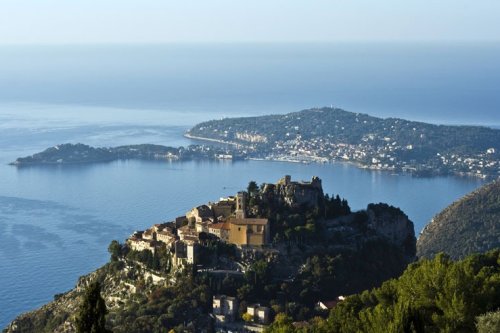 |
The rates on this trip are at a historic low right now. If you want
to join us, do not dawdle and allow the prices to go back up.
Carpe Diem - make your move now.
By the way, the cruise
write-up from last year's Greece 2008
Cruise is now complete. Read it and get a feel for
this year's trip ahead of time! Pay especially close attention
to Rome Part I and Rome Part II because I will be retracing our same
steps from last year if anyone wishes to join Marla and me.
|
|